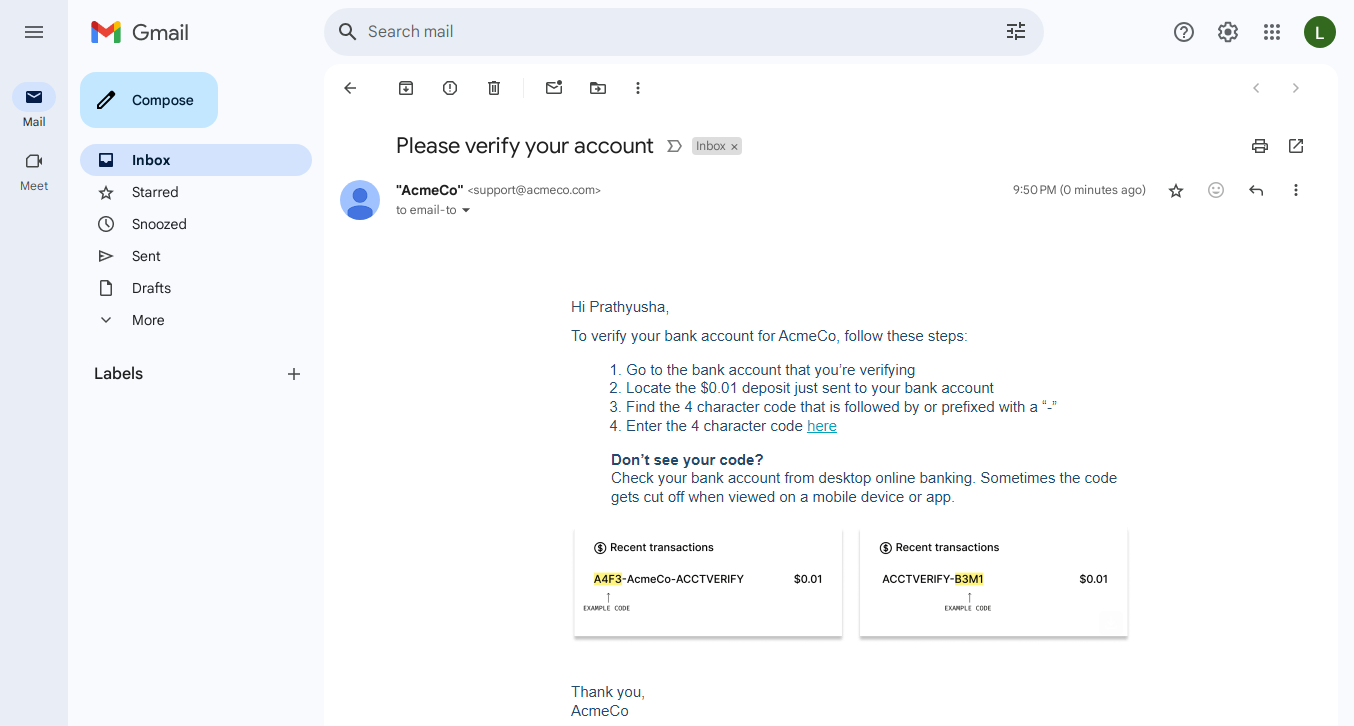How Verify Control Works
Orum verifies account control by sending a unique four-character code to the bank account of your end user and prompts them to authenticate it — removing the lost time and expense of microdeposits. Once the end user locates the code within online banking, there are two ways to confirm it:- API-based solution: Send back the code via the Control endpoint
- Orum Hosted Email Solution: Orum triggers an automated email to the end user with instructions on how to verify the code via an Orum-hosted website. This email comes from you, but is automatically sent by Orum.
A control verification also includes an account status verification. This means both
control_status and verification_status will update to validupon success.API-Based Solution
If you prefer owning the entire user experience with your brand, this is the option for you. In this option, Orum still sends a penny with a unique 4-character code to the end-user’s bank account. However, the rest of the experience is managed by you, the enterprise. Here’s how it works:- Your enterprise builds a self-branded interface for your end customers to submit their unique four-character code (for example, in your app or on a website)
- Your enterprise delivers the verification request to the end user and informs them of the steps they need to take to retrieve their unique four-character code
- Your end user enters the unique 4-character code through the interface you manage, which is then verified by Orum through our Control API
Orum Hosted Email Solution
If you don’t have the resources in place to build your own user experience, our hosted email solution could be a great fit. Here’s how it works:- Your enterprise sends a verification request and includes the end user’s email in the Verify request body
- Orum sends a penny with a 4-character code to the end user’s bank account
- Orum sends an email to the end user to prompt them to look for and enter the 4-character code in an Orum-hosted webpage
Example Email
Delivered from your domain but sent by Orum
Example Email
Delivered from your domain but sent by Orum

Email Delivery Timing
If using the email-based solution, Orum will send an email based on the following logic:- If the bank account is FedNow-eligible, the email is sent once a
verify_account_updated webhookevent returns averification_statusofvalid. - If the bank account is not FedNow-eligible, the email is sent during evening hours or the following morning of the next business day (if not a bank holiday).
Domain Configuration
Follow the below steps to enable Orum to send emails on your behalf securely and reliably. This process ensures your emails are trusted by recipients and aren’t marked as spam.- Verify Your Domain
- Add a special record to your domain’s DNS settings to prove ownership
- Set Up Email Authentication
- SPF Record: Authorizes us to send emails on your behalf
- DKIM Record: Adds a digital signature to your emails for better security and deliverability
- Use a Custom Mail Domain (Mail From): Emails will be sent from a custom domain like mail.yourdomain.com, to enable this a specific DNS records must be added
- Provide the records you need to add if you manage your DNS settings
- Verify and test the setup to ensure everything works as intended once the DNS updates are in place
Control Statuses
Regardless of whether you choose to use the API-based or email-based solution, the Control statuses and webhook events remain the same.| Ownership Status | Description |
|---|---|
Pending | Acknowledgment of the request being received |
Valid | A match has occurred and ownership has been verified |
Canceled | The maximum number of attempts has been reached, a transfer has failed, or it has been 5 days since the request was sent to the receiving bank |

